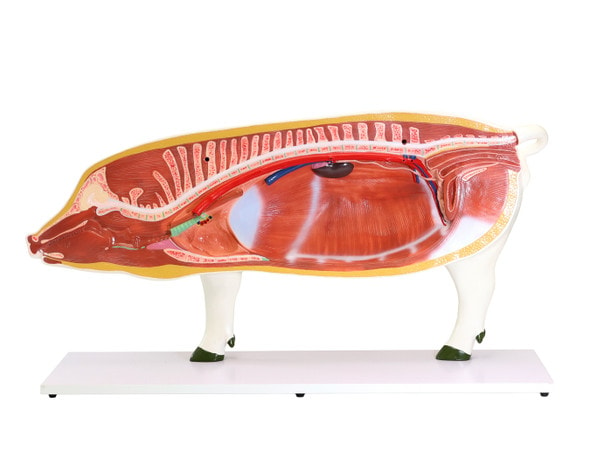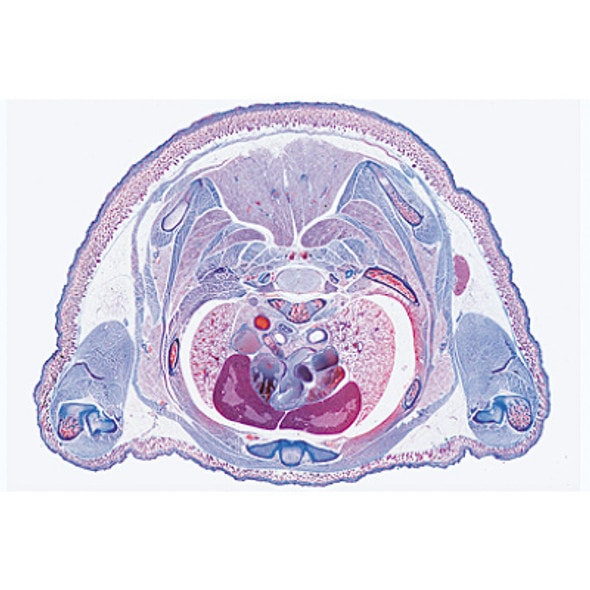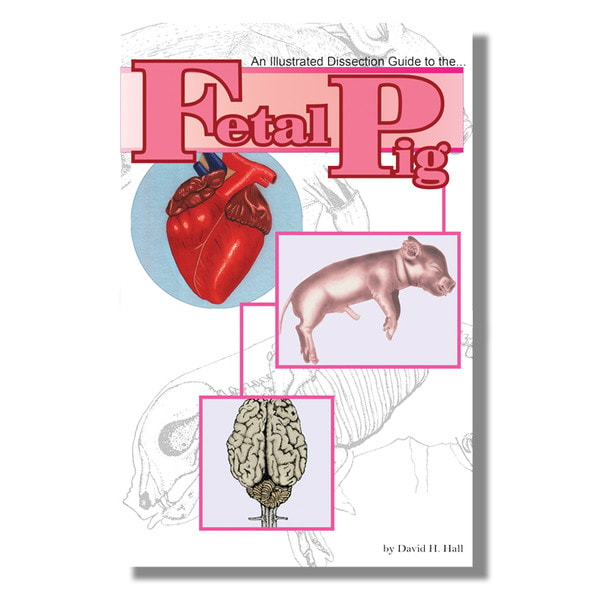Description
Skull of the Domestic Pig (Sus scrofa domesticus)
Overview
The skull of the domestic pig (Sus scrofa domesticus) is a critical anatomical structure of interest in veterinary studies, particularly in comparative anatomy, diagnostics, and surgical procedures. Understanding its detailed anatomy is essential for veterinary professionals and students to diagnose diseases, perform surgical interventions, and apply accurate clinical assessments to pigs and other related species.
General Structure
The pig's skull is elongated and robust, reflecting its omnivorous diet and complex social behavior. The skull can be broadly divided into three main regions: the cranium, the facial bones, and the mandible. The lower jaw in this model is removable.
1. Cranium
- Frontal Bone: The frontal bone forms the forehead region and contributes to the formation of the pig's cranium. It is relatively flat and broad, providing protection for the brain. The frontal sinus, a cavity within this bone, is clinically significant due to its involvement in respiratory diseases.
- Parietal Bones: These paired bones form the upper sides and roof of the cranium. They are relatively thin and provide important sites for muscular attachment.
- Occipital Bone: Located at the back of the skull, this bone forms the base of the cranium. The foramen magnum, a large opening in the occipital bone, allows passage of the spinal cord. The occipital condyles on either side of this opening articulate with the atlas vertebra, facilitating head movement.
- Temporal Bones: These bones lie beneath the parietal bones and house the middle and inner ear structures. The tympanic bulla, a bulbous structure, is part of the temporal bone and encloses parts of the ear. It is crucial for hearing and is often examined during otoscopic procedures.
- Sphenoid Bone: The sphenoid bone forms the base of the skull and houses the sella turcica, a depression that protects the pituitary gland. It also contains foramina for the passage of several cranial nerves.
2. Facial Bones
- Maxilla: The maxilla is the upper jawbone and holds the upper teeth. It also forms the floor of the orbit and contains the maxillary sinus, a site often involved in respiratory infections.
- Nasal Bones: These paired bones form the bridge of the nose. In pigs, the nasal bones are elongated, contributing to the characteristic shape of the snout.
- Zygomatic Bones: Also known as the cheekbones, these bones form the lateral walls of the orbit and contribute to the zygomatic arch. The arch provides a passage for the masseter muscle, which is involved in mastication (chewing).
- Palatine Bones: Located at the back of the oral cavity, these bones form part of the hard palate, separating the oral and nasal cavities.
- Vomer: The vomer is a thin, flat bone forming part of the nasal septum, separating the two nasal cavities.
- Premaxilla (Incisive Bone): This bone, located at the very front of the upper jaw, holds the incisor teeth. It plays a role in both feeding and grooming behaviors.
3. Mandible
- Mandible: The mandible, or lower jaw, is the largest and strongest bone of the skull. It consists of two halves, each made up of the body and ramus, that fuse at the mandibular symphysis. The mandible in this skull is removable.
- Body of the Mandible: This horizontal portion contains the lower teeth and provides attachment for the lower lip and tongue.
- Ramus: The vertical extension of the mandible, it provides attachment for the muscles of mastication. The condylar process at the top of the ramus articulates with the temporal bone to form the temporomandibular joint (TMJ), which is crucial for jaw movement.
Clinical Relevance
Understanding the skull anatomy is crucial for veterinary professionals for several reasons:
Disease Diagnosis
- Conditions such as sinusitis, otitis media, and dental diseases are directly related to skull anatomy.
- Abscesses or fractures of the skull can affect various vital functions, requiring precise anatomical knowledge for effective treatment.
Surgical Procedures
- Surgical interventions, such as trephination of the frontal sinus or dental extractions, require detailed anatomical understanding to avoid complications.
- The proximity of major vessels and nerves to the skull bones is crucial during head and neck surgeries.
Imaging Interpretation
- Radiographs, CT scans, and MRIs of the pig skull are often used in veterinary diagnostics. A thorough understanding of the normal anatomy is essential for identifying pathological changes.
Educational Importance
- Veterinary students and technicians must master the anatomy of the pig skull to excel in clinical practice. Detailed study helps in understanding comparative anatomy, which is vital when dealing with other species in veterinary medicine.
- Dissections and anatomical models of the pig skull are often used in veterinary schools to teach students about cranial nerves, dental structures, and bone landmarks.
Conclusion
The skull of the domestic pig is a complex structure with significant clinical importance in veterinary medicine. Mastery of its anatomy is essential for diagnosing diseases, performing surgical procedures, and interpreting diagnostic images. Veterinary professionals and students must have a thorough understanding of the skull's detailed anatomy to provide the best care for their porcine patients.















